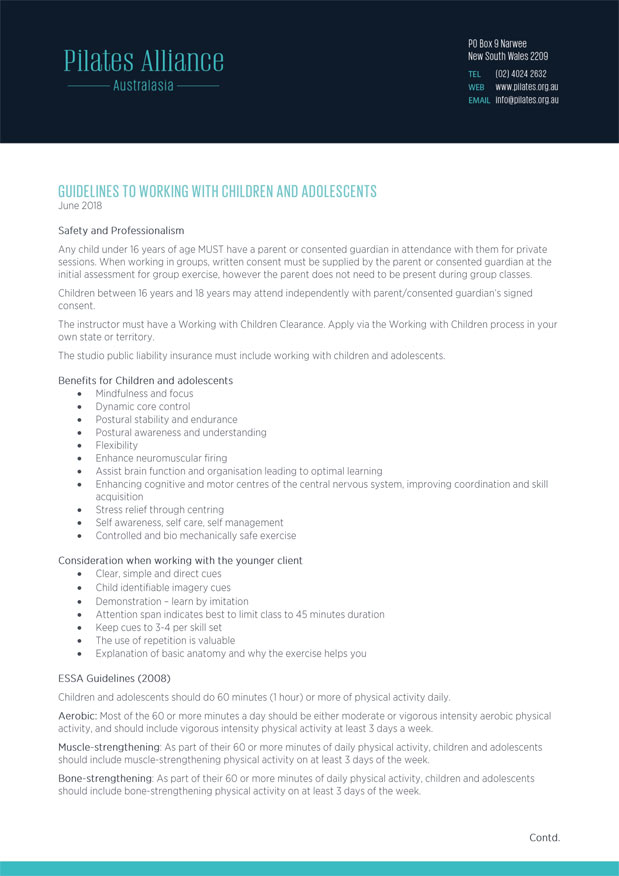Guidelines to Working with Children and Adolescents
Updated: 2022
Introduction
Children continue to develop physically and cognitively during their childhood and adolescent years. The Pilates Method can enhance this natural developmental process, whilst simultaneously combating the ill effects and poor postural habits developed through increasingly sedentary and technological lifestyles.
When working with children and adolescents, the following areas are important to consider:
Benefits of Pilates for children and adolescents
- provides controlled, safe exercise with attention to individual biomechanics
- develops postural awareness and encourages mindfulness in movement and at rest
- improves muscle balance, strength and flexibility
- develops dynamic stability and endurance
- enhances cognitive and motor centres of the Central Nervous System, improving coordination and skill acquisition
- reduces stress levels and improves self esteem through centering, concentration and body awareness
Professionalism and safety
- children under 16 years of age MUST have a parent or consented guardian in attendance with them for private sessions. When working in groups, the parent/guardian must supply written consent on the initial assessment for group exercise, however the parent does not need to be present during group classes
- children between 16 years and 18 years may attend independently with parent/consented guardian’s signed consent
- the instructor must have a Working with Children Clearance. Apply via the Working with Children process in your own state or territory
- Studio and Instructor Public Liability Insurance, must include working with children and adolescents
- the instructor must hold a PAA recognised Certificate IV qualification in Pilates (or the equivalent) to conduct mat work classes
- the instructor must hold a PAA recognised Diploma qualification in Pilates (or the equivalent) to conduct studio classes
- the PAA Code of Ethics requires members to maintain ongoing professional development and the PAA encourages members to seek further education relevant to their client base and work environment
- instructors and studios must comply with the PAA guidelines of equipment safety and maintenance
- instructors and studios must comply with PAA guidelines on exercise space requirements
- legal requirements for working with any client under 18 years of age include, Jurisdictional OH&S legislation, Civil Liability Law, Privacy Law, Consumer Law, Anti-discrimination Law, Criminal Law (this may include a National Criminal History record check or Working with Children check), local government policy for the use of public space for exercise. (From Fitness Australia 2017)
- The fitness guidelines can be viewed at Children’s Health and Fitness Services Guidelines
Initial assessment/screening
- every child must have an initial screening with a parent or guardian in attendance and the instructor needs to record full medical history, including neonatal history, developmental delays/milestones, learning difficulties, movement screening, fitness history. These notes must be documented and saved for a minimum of seven years
- if the child is under the care of another treating practitioner, prior to beginning any form of Pilates, the Pilates instructor should seek a referral from said practitioner
- the Pilates instructor should also document whether the child is under the care of a pediatrician or allied health professional and ensure correspondence with these practitioners, regarding any considerations or contraindications.
Considerations when working with the younger client
- class duration is best kept to 45 minutes to accommodate the attention span of the child/adolescent
- clear and simple direct cues should be used with no more than 3-4 per exercise variation
- use child identifiable age appropriate imagery cues
- include demonstration of exercises and movements as children learn by imitation
- use of repetition of an exercise for client mastery
- best practice is to teach fewer exercises per session but add variations of that exercise to consolidate the motor learning without boredom
- explain basic anatomy and exercise benefits in age appropriate language.
Contraindications/precautions
- observe contraindications and precautions that apply to the adult client
- younger clients should be supervised in all postures to ensure that individual anatomical parameters are not compromised (biomechanical and neuro-physiological)
- special attention must be paid when adding load with apparatus or body weight, to ensure movement remains functional. In particular, inversions (e.g. jackknife, rollover) and apparatus work should be taught with caution. Such exercises may be considered contraindicated, due to the potential load on bone growth plates.
Instructor: student ratio guidelines
- matwork is easily adapted for children, especially when incorporating small props to add challenge
- to encourage participation, make sessions fun and use imagination to develop the child’s connection with movement – eg, many exercises can be linked with movements from the animal kingdom
- the key to success and safety in studio work is the size of the child, the appropriateness of load and instability and whether the range of movement attained on the dimensions of the apparatus is valuable
- recommended instructor to student ratio for matwork = 1:8
- recommended instructor to student ratio for studio work = 1:4
Guidelines to exercise for children and adolescents
Children and adolescents should do 60 minutes (1 hour) or more of physical activity daily.
- aerobic: Most of the 60 or more minutes a day should be either moderate or vigorous intensity aerobic physical activity, and should include vigorous intensity physical activity at least 3 days a week.
- muscle-strengthening: As part of their 60 or more minutes of daily physical activity, children and adolescents should include muscle-strengthening physical activities on at least 3 days of the week.
- bone-strengthening: As part of their 60 or more minutes of daily physical activity, children and adolescents should include bone-strengthening physical activities on at least 3 days of the week.
References
- Children’s Health and Fitness Services Guidelines
- Excercise for Kids – An e-book by ESSA
- Physical Activity and Exercise Guidelines for All Australians – Children and young people 5 to 17 years
- Corey-Zopich, C. Howard, b. Ickes, Dawn Marie. 2014. Pilates for Children and Adolescents Manual of Guidelines and Curriculum, PMA Pilates Method Alliance

